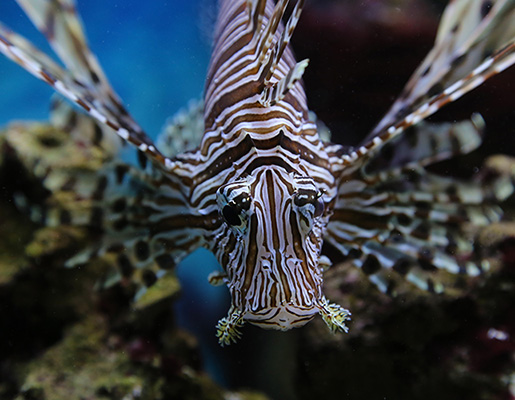Lionfish
You can’t beat them…so let’s try to eat them
Diving in the Florida Keys at the age of 15, Erin Spencer caught a glimpse of a beautiful fish.
The rocky-textured fish swam gracefully in shades of bright orange behind scaly white stripes. Its dramatic spines stretched out from its body as its fins rippled in the water.
This stunning fish, the lionfish, soon proved to be a major threat to the area’s marine ecosystems, preying on anything it can swallow.
 Soon after her dive, Spencer learned just how much of a threat these fish were to the reef. Lionfish are an invasive species on Florida reefs and a particularly successful one. They can reproduce every four days, and females can produce two million eggs annually. They have no natural predators, and so the lionfish population has been growing exponentially since 2009.
Soon after her dive, Spencer learned just how much of a threat these fish were to the reef. Lionfish are an invasive species on Florida reefs and a particularly successful one. They can reproduce every four days, and females can produce two million eggs annually. They have no natural predators, and so the lionfish population has been growing exponentially since 2009.
One reason this invasive species continues to thrive is because of its highly effective defense mechanism—large venomous spines with a sting that almost no creature can withstand. It soon became evident that the only solution was to try to manage the population of the invasive species instead of continuing the seemingly futile eradication approach.
‘They’ll make you wish you were dead’
“The spines won't kill you, but they’ll make you wish you were dead,” said Spencer, now a member of the Class of 2014 at William & Mary. When Spencer, an ecology major and marine science minor, began to brainstorm ideas for a senior honors thesis, she knew immediately that she wanted to study lionfish.
 Originally from the Indo-Pacific, lionfish are a very popular aquarium fish in the U.S. Spencer said genetic evidence suggests that the invasion began with individual specimens being released from personal aquariums. These fish reproduced rapidly to create the problem the reefs are facing today.
Originally from the Indo-Pacific, lionfish are a very popular aquarium fish in the U.S. Spencer said genetic evidence suggests that the invasion began with individual specimens being released from personal aquariums. These fish reproduced rapidly to create the problem the reefs are facing today.
“Imagine having an aquarium and getting stung or putting a lionfish in your tank and having it eat some of your expensive fish. People don’t want to kill it but they want to release it,” said Spencer.
Funding through William & Mary’s Monroe Scholars program, coupled with a research grant from National Geographic allowed Spencer to develop what she came to call the Lionfish Project. The Lionfish Project aims to track local response to the lionfish invasion in the Florida Keys. Spencer explained that although there has been some action taken by the government, Florida natives are now combating the lionfish invasion themselves.
“Their entire livelihood relies on the reefs, and they were starting to see the effects. More people were being stung and divers were seeing the population growth firsthand,” said Spencer, “Once they made the connection that these fish are the reason the reef is suffering, people took action.”
Off the reefs and onto the menus
There is one factor working for the people who are trying to control these invasive fish: The lionfish is good to eat. Local groups are hoping to use the edibility of the fish to get them off the reefs and onto the plates of seafood lovers.
Divers are being encouraged to hunt the species and organizations such as the Reef Environmental Education Foundation (REEF) are spreading awareness. Local chefs also have taken lionfish into their kitchens and have turned lionfish management into a new cuisine.
For the Lionfish Project, Spencer interviewed people involved with the issue, particularly those involved in the effort to change the status of lionfish from that of invasive species to the catch of the day. She met with local chefs, REEF personnel, fishermen and divers, distilling what she learned into a web site and blog. (Her National Geographic Explorers Journal blog entry “Top 5 Myths About Lionfish” has been picked up by several diving and travel websites—see sidebar.)
In addition, Spencer wrote about her lionfish adventures in her William & Mary blog. In October, she gave an oral presentation at the 2013 Summer Research Showcase, an annual event that highlights the undergraduate research supported by William & Mary’s Charles Center, which administers the Monroe Scholars program. Spencer found that lionfish are starting to be seen on restaurant menus, but she said that the demand remains low.
Difficult to handle as well as to harvest
She explained that lionfish are difficult to harvest. They live on reefs and therefore can’t be netted like open-ocean fish. Spencer found that in recent years, Florida lobstermen find lionfish as an unwanted bycatch in their traps. Spearfishing for lionfish is popular, but not practical on a commercial level.
“A typical day of diving yields less than 20 lionfish per diver,” said Spencer, who explained that a large part of the public’s reluctance stems from fear that venomous spines might affect the lionfish meat. “You’re talking to these fishermen that could be bringing in valuable fish they know people would want and they’re getting less money for the lionfish meat.”
Spencer believes the next big step is to get the word out to increase demand for lionfish. Residents of the Keys have accepted lionfish as food, but she said a marketing campaign is needed to move the invasive species beyond being a local delicacy. An increased demand in lionfish would increase the need for hunts and help lower the population.
“Any sustainable restaurant can tell their customers they are eating an invasive species and saving the reefs. Once people decide they have a taste for lionfish, researchers are hopeful the demand will increase,” said Spencer.
Seafood lovers who haven’t had the opportunity to try them won’t be disappointed to see lionfish on the menu. Spencer raves that lionfish are some of the best fish she’s tasted—and completely safe to eat.
“It’s a white flaky filet but a little bit more buttery than similar fish. You can make it any way you would make a flaky filet,” said Spencer.















